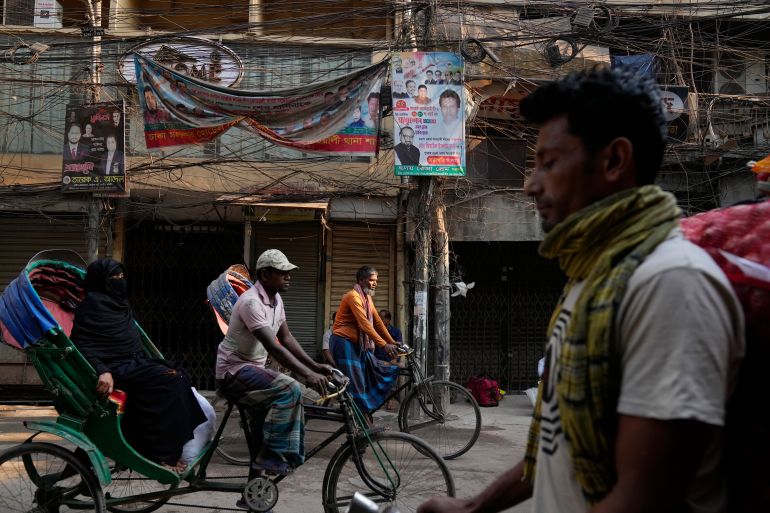How Bangladesh rickshaw pullers saved lives amid quota protest clashes
Risking bullets, they stepped out of their homes to save their livelihoods. They ended up saving lives too.
A cycle rickshaw puller pedals with a passenger in the old quarters of Dhaka, Bangladesh, March 13, 2023 [Aijaz Rahi/AP Photo]By Masum Billah and Faisal MahmudPublished On 26 Jul 202426 Jul 2024
Dhaka, Bangladesh – The air crackled with tension in Mouchak, a central district of Bangladesh’s capital Dhaka. It was Friday, July 19, and the streets were already filled with tens of thousands of protesters, their fury heightened by the deadly events of the previous day. A brutal police crackdown and clashes with activists of the governing Awami League party had claimed the lives of dozens of students, pushing the city to its limits.
The usual tranquility of the weekly Jummah prayer, a time for Muslim peaceful reflection, was hours away. Right then, the atmosphere was charged with unrest. Police, overwhelmed and outnumbered, retreated amid a barrage of stones, using tear gas and sound grenades in a desperate bid to maintain control amid mounting chaos.
Keep reading
list of 4 itemsend of list
A group of rickshaw pullers found themselves caught in the fray. A tear gas shell flew towards them, prompting a hasty retreat towards the nearby Malibagh Circle, a bustling avenue. Their retreat was accompanied by defiant voices raised in protest against the authorities: “If anything happens to us [rickshaw pullers], we will ignite fires in every house!”
Among them was Shaheen, originally from Cumilla district some 180km (112 miles) away.
“It was a horrifying scene,” he recounted, his voice trembling, the memory still vivid in his mind. “The police were firing at the protesters, who were retaliating by throwing stones. I managed to escape unharmed by pedalling my rickshaw as fast as possible to save my life.”
Yet, the rickshaw pullers didn’t just escape — they saved lives as Bangladesh descended into the bloodiest clashes it has seen in years. What had begun as a student-led protest for quota reforms in government jobs had erupted into a nationwide upheaval, fuelled by escalating violence and broader frustrations with the government. In a span of just five days, from July 16 to July 20, Bangladesh descended into turmoil. At least 197 people were killed amid widespread protests and a harsh crackdown by law enforcement forces.
Following the deaths of numerous protesters on July 18, tensions soared, prompting the government to take drastic measures: an internet shutdown that it blamed on “terrorist activities targeting data centres and ISP cables”, and after fresh clashes on July 19 in which at least 56 more people were killed, a nationwide curfew that it only began to relax this week.
Through it all, the city’s defiant rickshaw pullers were out on the streets.
‘I didn’t charge any fare’
An estimated 400,000 to 600,000 rickshaws navigate the city’s thoroughfares on any given day. The protests, the shutdown of businesses and the subsequent, strictly enforced curfew dealt a devastating blow to their earnings: Shaheen’s earnings plummeted to 150 taka ($1.28), — compared to the 800-1000 taka ($6.8 to $8.5) he usually earns — barely enough to cover the 120 taka ($1) rent owed to the rickshaw owner.
But staying at home amid the mayhem on the streets wasn’t an option.
“What good is fear if we die of hunger?” asked Shahabuddin, a young rickshaw puller supporting his mother and sibling after his father’s passing. Venturing out amid the clashes was a matter of survival. “We brave the violence because we are hungry,” he said. “What is the use of living if I have to see tears in my mother’s eyes due to hunger?”
On July 19, that survival instinct also helped save many others.
Swapan, a rickshaw puller from the northern district of Mehendiganj, transported a man bleeding from bullet wounds in the Banasree area of southern Dhaka.
“I took him as far as the Goran Tempo Stand, but he was bleeding profusely,” Swapan recalled. “I advised his companions to find an autorickshaw to get him to the hospital quickly since rickshaws are too slow. I didn’t charge any fare for it.”
In Mohammadpur, Kashem, a rickshaw puller, undertook at least five trips to nearby hospitals, transporting injured students and civilians. “People were wielding sticks and hurling bricks, but the police fired live bullets, causing numerous injuries. I took it upon myself to ferry them to hospitals,” he said.
Like Shahabuddin, Kashem said that he couldn’t afford to stay at home despite the risk of stepping out in the violence, as his family relied on his daily earnings.
A city recovering
By Monday afternoon, as the city remained tense, Shahabuddin had earned a mere 50 taka ($0.43), less than the rent he owed for his rickshaw.
He recounted a harrowing incident in Banasree, where he found himself trapped in a violent clash on Monday, saved only by the intervention of fellow rickshaw pullers.
“There was firing from police and activists of the ruling party, and I was caught in the middle of the road. I couldn’t abandon my rickshaw as that would have meant owing a large sum to the owner. Suddenly, a few fellow rickshaw pullers arrived and helped me reach safety.”
But the fear and exhaustion have taken a toll.
Zahangir, a rickshaw puller, braved the streets for three days during the protests. Hours of pedaling, evading tear gas and confrontations, have left him drained and disheartened. “My face felt like it was on fire, tears streaming down,” said.
Now the standoff must end, said Shaheen, another rickshaw puller. “This cannot continue indefinitely,” he said. “The lives of ordinary people like us have been put on hold. We seek peace.”
*The last names of the rickshaw pullers have been withheld to protect their identities.
